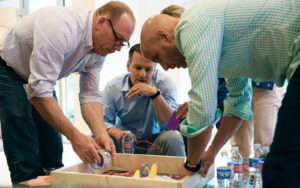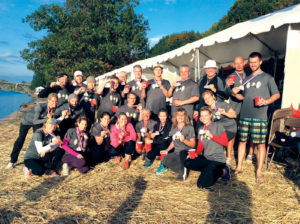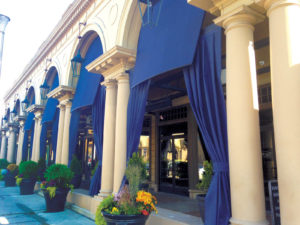
Centering business processes on continual improvement clears the path for innovative ideas to become innovative products.
Every industry-changing product started as a great idea. But without an effective organizational structure in place, not every great idea has the opportunity to come to fruition. A good manager knows this. An innovative manager puts it into practice.
While it’s not possible—or even ideal—to manage every company the same way, those that continually deliver innovative products have one thing in common: a consistent focus on improving the satisfaction of the two key players who affect economic success—the employee and the customer.
Innovation vs. invention
Before mapping out business processes, company leaders must define their end goal: innovation or invention? What is the difference, and how does one stay on the path to innovation? Suzie Roberts, vice president of custom fabrics at Glen Raven Inc., Glen Raven, N.C., offers a straightforward definition: An innovative product has new, creative and unique features not currently available in the market.
“A strong R&D function is constantly looking at both invention and innovation,” adds Peter McKernan, IFM, president and CEO of Herculite Products Inc., Emigsville, Pa., who notes that 30 percent of his company’s sales come from products it wasn’t even making four or five years ago. “Innovation is taking technologies and concepts used in different markets and figuring out how to use that solution in a different way to improve another product or process.”
While the term itself is now overused, says Bob Rosania, IFM, CPP, CEO of Ehmke Manufacturing Co. Inc., Philadelphia, Pa., the right approach to achieving it is not as common. “The genius often lies in simplicity. Complex and sophisticated approaches typically do not lead to an innovative solution,” he explains. “I often use the sports analogy of the Green Bay Packers championship football teams under Vince Lombardi. His teams maybe ran a total of eight offensive plays, but those plays were simple and executed to perfection.”
Alternative approaches
Ehmke’s company philosophy is rooted in the lean manufacturing structure, which is described as an approach that aligns everything in the business to deliver increasing customer value—orienting people and systems to deliver a continuous stream of value to customers, and eliminating waste and deficiencies in the process.
To simplify the flow of information, Ehmke’s departments are structured—with very little middle management, Rosania notes—around five job functions: sales and marketing, finance, engineering, operations and quality. All of the product lines share resources in each of these functions. “A continuous loop of measuring and adjusting helps improve our efficiency,” Rosania says. “Therefore, we track very closely our one-piece flow and first-time quality. We encourage employees to question the status quo and ingrained beliefs to improve the process and do what we do best each and every time.”
A specifically outlined structure also works for an even smaller company: Signature CanvasMakers in Hampton, Va. “Having detailed, written processes and standards are the foundation of our success,” says Charlene Clark, IFM, owner. “It is the means by which we ensure that every aspect of a job is executed efficiently and effectively without unapproved variations.” Clark’s team includes her husband and five full-time employees: a sewing team of two and a pattern/installation team of three.
In 2013, Clark received her Industrial Fabric Manager (IFM) certification, offered by IFAI to help company leaders tell customers they have superior knowledge of the principles and practices of business and organizational management. “I felt that obtaining my IFM was a way to challenge myself to focus on and evaluate business principles and organizational management for us as a small business,” she recalls. “We had just purchased a building at the time I was working on my IFM. It represented a time of change for our business and the possibility of a new venture into a retail environment. Writing the IFM essay questions and mock business plan turned out to be very timely and allowed me to apply our actual situation throughout my research and evaluation. It also allowed me to take a step back and take a more objective look at my business overall.”
For Herculite, structure and silos are not the management choice. McKernan says: “We prefer not to be restricted by organizational boundaries but rather be empowered to create a fluid, agile and proactive environment in which day-to-day work cuts across specializations and market segments.” McKernan is also IFM certified. “It’s a reflection of support for our member-owned association,” he notes. “As someone blessed to lead one of our industry’s most recognized participants, it was incumbent upon me to reinvest in the industry that has provided our team with so many opportunities.”
Collaboration in common
The degree to which department boundaries are defined does not make or break product development. A collaborative effort is what transforms suggestions into success stories, as an environment that empowers all employees to participate in the product development process typically sees improved time to market.
“We have a company-wide platform for all employees to submit ideas,” Roberts says. “These could be process improvements, new uses for our current products or new product ideas. We have many ideas, and we have to focus on which ones we want to pursue, and when. The market and consumers crave new products more frequently.” To help prioritize, Roberts and her team assess what is achievable and the timeline associated with each. “Our strategy is to not count anything out,” she continues. “Something that may seem bizarre could uncover a process or idea about how to improve or change what we are doing. From manufacturing to daily work flow to product launches, there is a constant evaluation of all processes. We strive to learn from what went right to what went wrong, and why.”
With no formal process in place, Clark also encourages employees to offer input and suggestions. “Oftentimes, the best ideas come when someone is able to look at things with a fresh set of eyes and a different perspective,” she explains. “Introducing a new product is an investment in time and money. It’s important to fully evaluate the scope of the project, the level of appeal it would have to a broader audience, the cost to produce and distribute and the volume you would need to sell in order for it to be
a profitable venture.”
Stages of development

“Product development is essential to the long-term sustainability of our company: Fail fast and fail cheap, then move on to the next qualified idea,” Rosania says. Ehmke implements a stage/gate R&D methodology with a new product development scorecard—a possible new product must achieve a certain score before it moves to the next stage.
Herculite has crafted an Innovation Funnel to continuously evaluate and allocate resources that drive to its three innovation horizons: Horizon 1 focuses on today—incremental improvements to existing products or services; Horizon 2 focuses on tomorrow—next-generation platforms for existing and new markets; and Horizon 3 focuses on transformational breakthroughs that go beyond tomorrow. “Innovation belongs to all of our associates and is a part of everyone’s job responsibility,” McKernan says.
Retain your biggest asset
Even with the most streamlined processes in place, a successful company is nothing without motivated employees who feel valued at work. “Our employees are our biggest asset,” Roberts says. “We want them to know they are part of the process and success.”
Finding the right employees is not an easy task, which makes retaining them even more important. “This industry has a lot of gray areas, and while we can train someone to follow a process, we cannot teach a strong work ethic or the ability to think and see beyond just what’s written on a piece of paper,” Clark says. For her employees, the little things make the difference: flexible work schedules, birthday recognition, company lunches, holiday traditions and other personal touches.
“Recruiting and hiring any successful employee is an extremely difficult task,” Rosania agrees. “We attract innovative employees with the promise that they can make an immediate impact on our business. Education and skill development are key.” Ehmke provides job-specific training and development opportunities, such as continuing education classes. “A fair compensation with the ability to earn more through greater effort is what brings people back each day. If we can be successful at providing these items for our employees, we can keep them.”
Herculite developed its own apprenticeship program more than 10 years ago to improve the skill set, value and contribution of its associates. It also supports internship and scholarship programming with local universities.
“We create a framework for success, providing resources and tools to empower their entrepreneurial spirit,” McKernan says. More recently, annual performance reviews were replaced with a continuous performance management process that provides real-time, transparent and relevant feedback that accelerates individual and organizational achievement.
Customers at the center
When employees are passionate about the products of their labor, ensuring customer satisfaction becomes more than just another part of the job.

“Extraordinary results occur at the intersection of where our impassioned associates connect and commit to the continuous pursuit of excellence on behalf of our customers,” McKernan says. Herculite has even adapted its structure to become more customer-centric. “We started with a typical organizational pyramid, flattened it and inverted the pyramid, reflecting our belief that our customers’ interests and needs are the pinnacle,” he explains.
Ehmke also strives to keep the voice of the customer at the forefront, stressing the need to simply do the right thing. “We’re proactive in our responses—good news or bad news is delivered early,” Rosania says. “Don’t hide behind emails and voice messages. At the end of the day, a customer wants to be heard, respected and productive.” Rosania’s IFM certification is also for the benefit of the customer. “It shows our customers our dedication to the industrial textile industry,” he says. “None of our customers require certification as a condition of receiving work, but it does provide verification.”
Too often, new ideas are lost in the shuffle of managing day-to-day operations. Simplifying and aligning internal processes and priorities with the company vision—to increase customer satisfaction by continually improving upon their basic business needs—provides a clear path for empowered employees to move novel ideas from concept to completion.
Holly Eamon is an editor and writer based in Minneapolis, Minn.
Staying up to date on which markets are poised for growth, as well as what tools and technology will better support their teams, is crucial for company leaders tasked with guiding innovation in specific directions at the most opportune times.
“Our teams stay on top of the latest technologies and materials, and we analyze what could be beneficial for our businesses today or in the future,” says Suzie Roberts, vice president of custom fabrics at Glen Raven Inc., Glen Raven, N.C. “In general, we see performance textiles growing in all markets. The shade category is certainly showing signs of innovation through umbrellas, shade sails, cabanas and awnings. We also see upholstery growing.”
Herculite Products Inc., Emigsville, Pa., also makes an effort to invest in technology. For example, it recently completed a major investment in expanded analytical and physical testing capabilities to support ancillary engineering equipment and facilities. The company is also installing high-resolution vision systems in its manufacturing center. Peter McKernan, president and CEO, expects the graphics and sign industry to continue to be an area of growth. He also mentions the military market, which is echoed by both Bob Rosania, CEO of Ehmke Manufacturing Co. Inc., Philadelphia, Pa., and Charlene Clark, owner of Signature CanvasMakers, Hampton, Va.
Clark, who recently purchased a cutter/plotter to help her team be more responsive on repeat production-oriented projects, notes that she is in a highly concentrated area for all military branches. “With the new administration and the prospect of increases in defense spending, we expect to see an influx in military and government contractor spending,” she predicts.
 TEXTILES.ORG
TEXTILES.ORG


